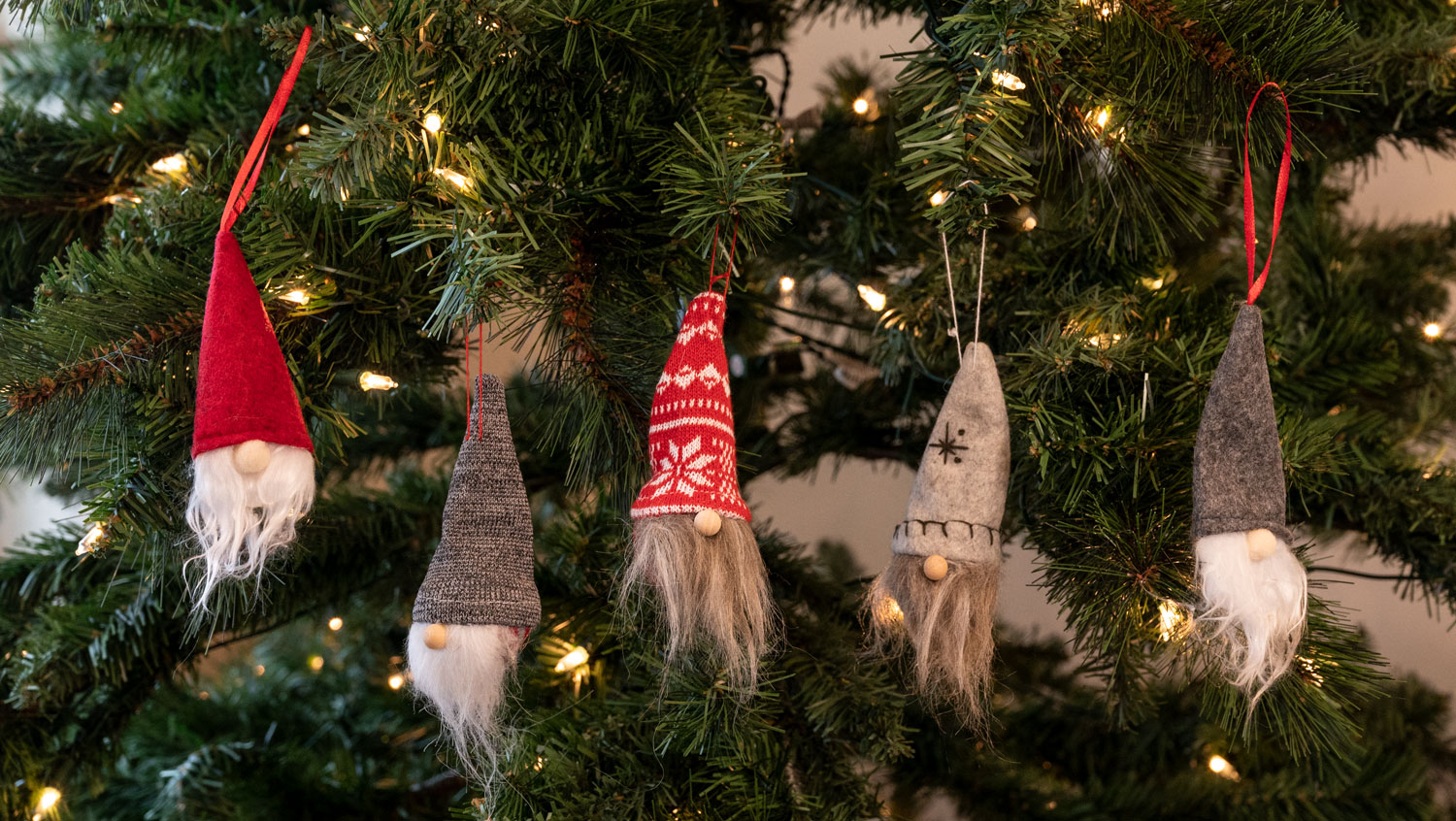Christmas Gnome Infestation
Photos by Forrest Anderson
If you think fireworks will detonate if anyone brings up politics at your Christmas dinner, try changing the subject by uttering the word “gnome.” That’s when the real sparks will fly.
The civilized world is clearly divided into two groups – gnomophiles and gnomophobes, both with deeply held opinions for or against the mischievous little folk in pointy red hats that peek out at humans from flowerbeds.
This year, the gnome wars have been in full swing because of a particularly fanatical marketing blitz by gnomophiles that has splashed gnomes all over Pinterest boards and ads for Christmas decorations. “Gnome for the Holidays,” “Home Sweet Gnome,” DIY tutorials in how to cut up your socks and make gnomes out of them, dog gnomes and gnomes for dogs, how to turn your Christmas tree into a gnome, how to recycle your toilet paper rolls into gnomes, how to make gnome boots out of red plastic cups and gnomes out of flower pots or pine cones….
I’m out of breath and I haven’t even gotten to the cookie gnomes and the knitted gnomes. Clearly, gnomophiles are on the march. They won’t be satisfied until we all have hairy little bearded guys with bulbus noses swinging all over our Christmas trees.
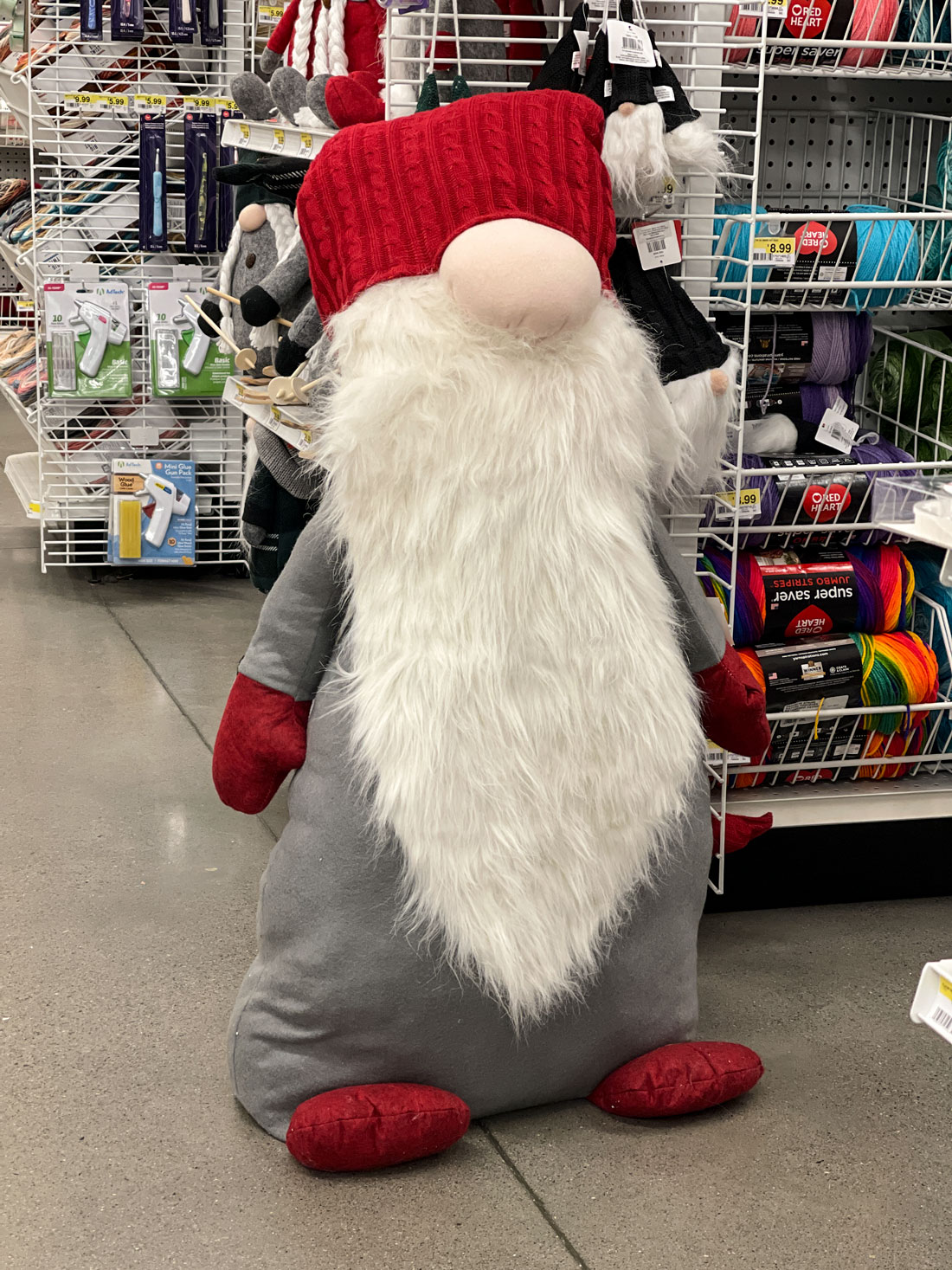
We caught this gnome ambling down an aisle at Joann's.
So…. Why? A look at gnome history helps explain this year’s gnome infestation, a phegnomenon that typically happens every few years.
Gnome History
Gnomes are ancient and are believed to have evolved from a mixture of several mythological gene pools. Ancient Greeks, who were given to placing statues around here and there, set up in their gardens statues of Priapus, their god of vegetables and gardens. His job was to protect plants and animals and to act as a scarecrow to keep birds away. The Greeks also contributed a word, genomos, or earth dweller, from which the term “gnome” is thought to have evolved when the “e” was left out of it in a much later typographical error. The Romans, as they were wont to do with anything Greek, picked up on the idea of protective garden statues and ran with it, apparently placing garden statues all over the empire. I won’t go into what the statues were like, but as they weren’t in good taste or properly dressed except for a hat, they are likely to have created the first gnomophobes.
By the Renaissance, when all things Roman came into vogue, gnomes had evolved into little beings with magical powers who came out at night and were called “gobbi” in Italian.
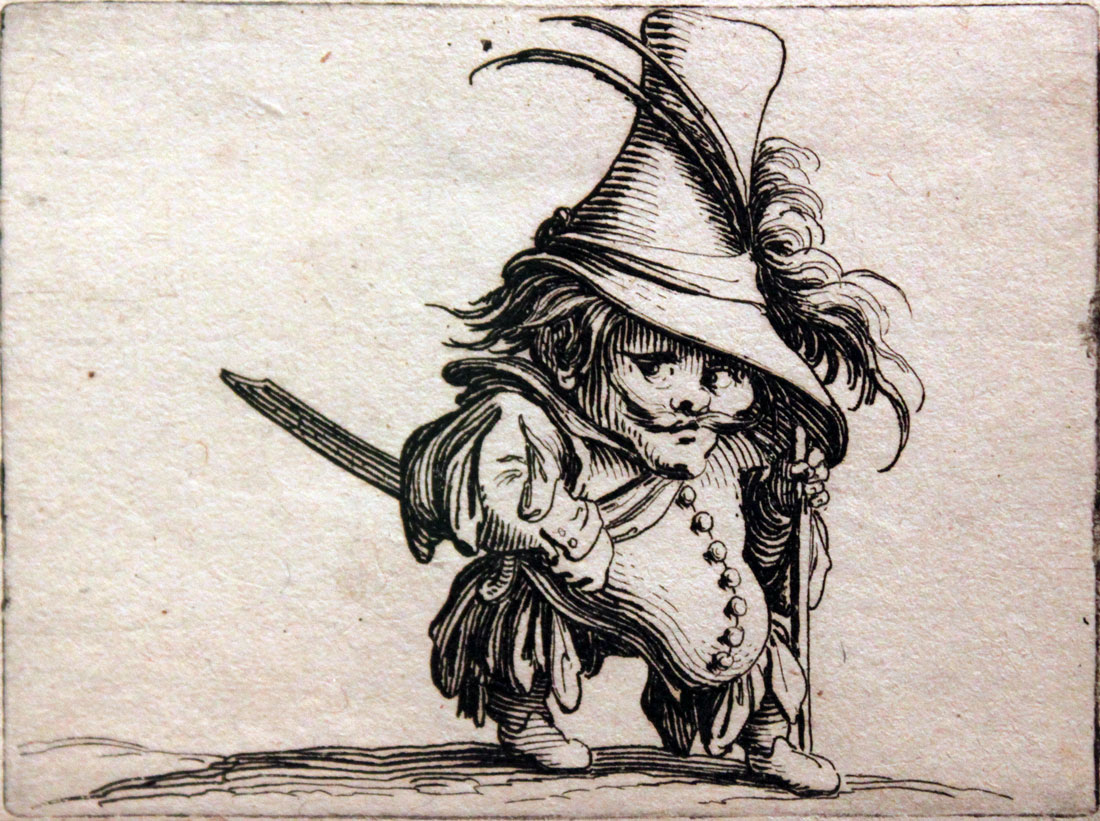
In 1616, baroque printmaker Jacques Callot produced 21 drawings of gnomes which he called Gobbi.
In folklore of Germany and other European countries, they used their magical powers to help people with farming and guard underground treasure that they sometimes shared. In Denmark and Norway, similar creatures were called nisse, while they were called tomte in Sweden, duende in Spain, hob in England and kabouter in the Netherlands.
Gnomes by all the names give advice to farmers and are associated with environmentalism because they are guardians of nature and animals. They don’t allow humans to know the location of their burrows or teach non-gnomes their language and they appear only when they want to. Rübezahl, the lord over the underworld, was sometimes referred to as a mountain gnome.
According to Scandanavian tradition, the nisse, if treated well, will protect a farm and family from evil and misfortune, and help with farm chores. We particularly like this part, which is why we created a sweet little iOS app called Home Gnome, which helps people keep track of their home maintenance chores.
However, they are short tempered and easily offended by lazy or disrespectful farmers. In retaliation, gnomes have been known to box the offender on the ears, play pranks, steal, maim or kill livestock or bring economic misfortune to a farm. They particularly dislike swearing and mistreatment of animals.
They can change shapes and make themselves invisible so people can get only brief glimpses of them. They have four fingers on each hand, sometimes pointed ears, and eyes that reflect light in the dark like those of a cat. They typically are one to three feet tall, although there are miniature nisse as well.
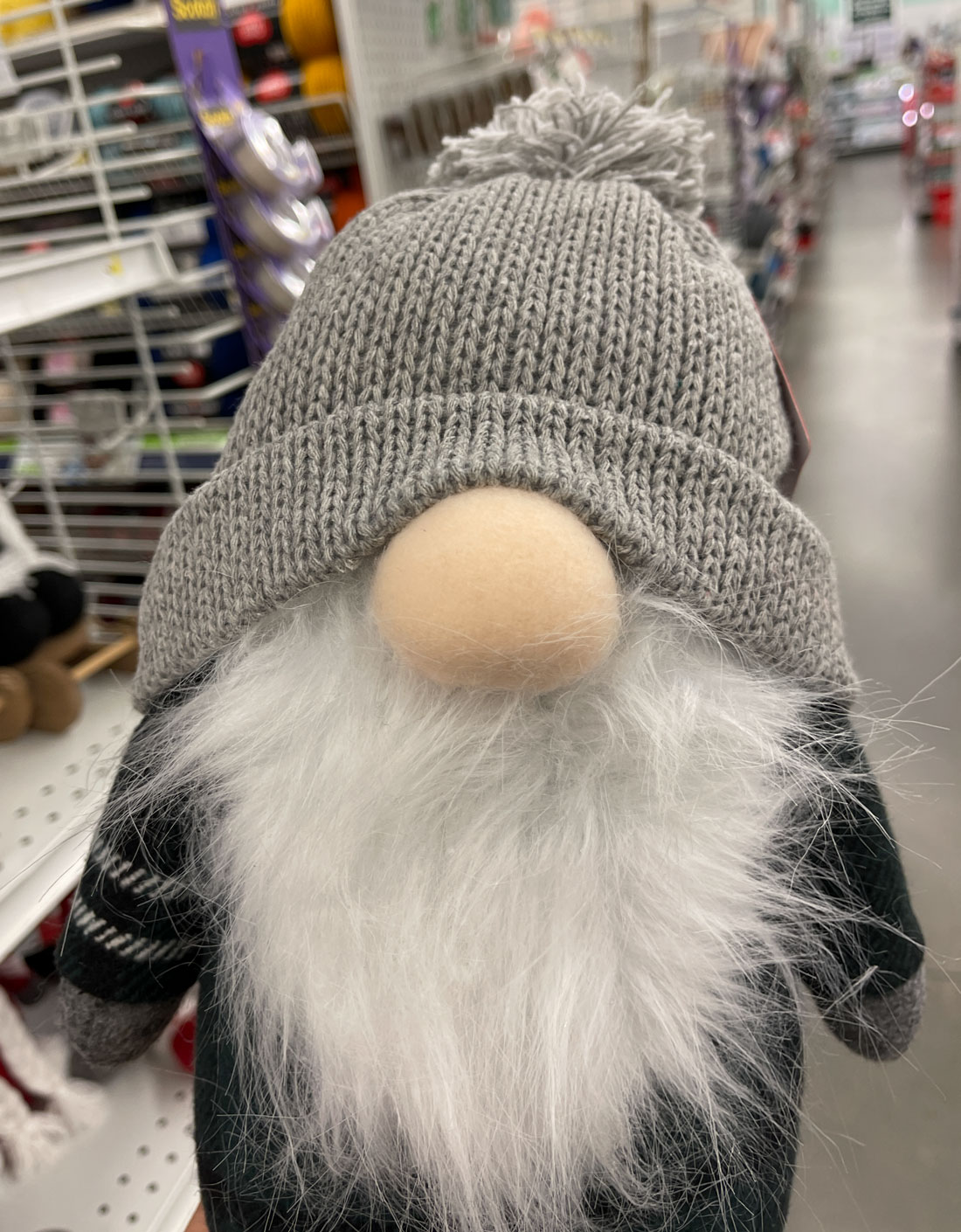
Gnomes often wear their hats down over their eyes because their eyes are sensitive to sunlight, since they live in burrows and typically come out at night.
They like farmers to leave them a bowl of porridge with a pat of butter on top on Christmas Eve. If they don’t get it or it isn’t made right, they may tie the cows’ tails together in the barn, turn objects upside down or break things. Their favorite horse is always the healthiest one on the farm, and they will braid its mane and tail but will bring misfortune on the farm if someone takes the braids out. A nisse’s bite is poisonous and requires magical help to heal.
They live under the floorboards of homes and pop out with the first snow to start cleaning and inspiring humans to do holiday baking.
In ancient times, nisse and tomte were believed to be the "soul" of the first inhabitant of the farm who cleared the land where the house sat. The nisse or tomte lived in the burial mounds on the farm. The word tomte is in an idiom, hustomten, which means a caretaker of a property or someone who mysteriously does a favor.
After Scandanavia christianized, the nisse were seen as heathen and connected with the devil. Farmers who believed in them could be seen as worshipping false gods and risking their soul. A sign of such behavior was unusual prosperity, which could bring public condemnation.
At Christmas, nisse/tomte are accompanied by a mythical Yule goat in knocking on the doors of people’s homes and handing out presents.
German scientist and alchemist Parcelsus wrote A Book on Nymphus, Sylphs, Pygmies and Salamanders, and on the Other Spirits, published in Poland in 1566. He wrote that “gnomus” were skilled in magic and alchemy. The Oxford English Dictionary said that Paracelsus’ omission of the ē in the word “genomus” was a goof. Gnomus were as tall as the distance from the thumb to the tip of the little finger on an outspread hand. They could move easily through solid earth, Parcelsus wrote.
Gnomes were considered generally helpful, but you couldn’t depend on it. They were blamed for causing a landslide that destroyed the Swiss village of Plurs in 1618. The story goes that they poured liquid gold into a vein so that the villages could mine it, but were displeased when the resulting prosperity corrupted the villagers.
Gnome statues made of wood or porcelain were popular household decorations in the 17th century.
The English word gnome dates from literature of the early 18th century, by which time gnomes were status symbols in gardens of some wealthy families. The Roman emperor Hadrian had had hermits living in his villa garden, and 18th century wealthy landowners did the same to provide a rustic ambiance. Hired hermits would live in a rustic hut, wear unkempt clothes and let their beards, toenails and fingernails grow long. It apparently was hard to get people to perform this job, because it wasn’t long before gnome lovers went back to statues.
In 1847, Sir Charles Isham brought 21 terracotta gnomes produced in Germany by Philip Griebel back to Britain. He placed them in his gardens at Lamport Hall in Northamptonshire. Nicknamed "Lampy", the only gnome that survived is on display at Lamport Hall. It is insured for a million pounds.
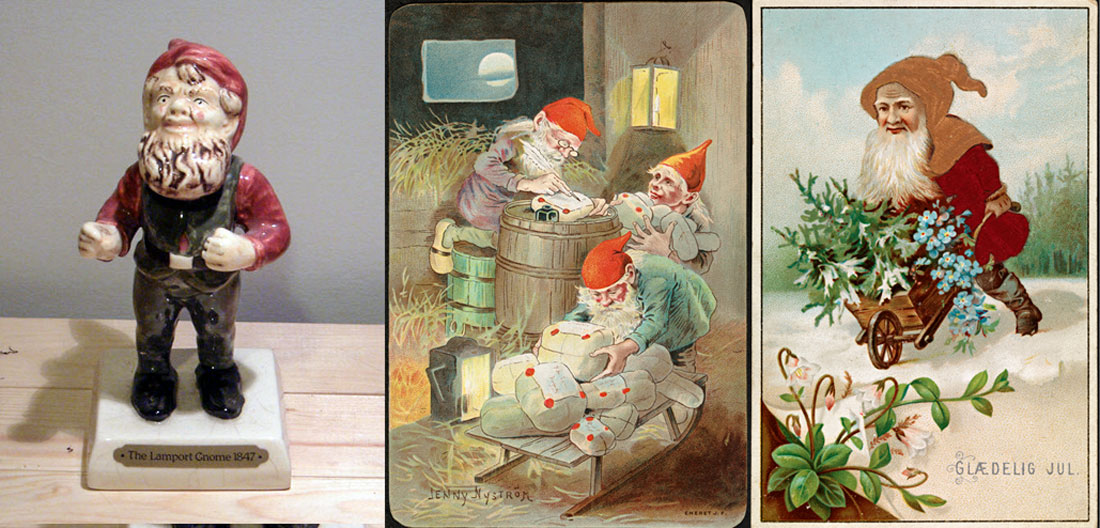
The famous Lampy gnome, a Swedish Christmas card and an 1885 greeting card with a gnome on it. Photos available under a Creative Commons license.
Numerous companies in Germany produced gnomes, and they became popular across Europe. The owner of the second largest collection of garden gnomes in Britain, Sir Frank Crisp, opened his gardens to the public at least one day a week from 1910-1919.
A French satire called Compte de Gabalis noted that gnomes were quite numerous, with the earth being filled almost to its center by them.
German gnome manufacturers Philipp Griebel and August Heissner produced the first mass-produced garden gnomes in the 1870s. Heissner became gnown worldwide for his gnomes.
Gnomes in some 19th century literature were described as being miners, but in others gnomes were more like brownies or leprechauns who were household spirits.
Gnomes’ popularity fell during World War I, as Germany had been the chief manufacturer of gnomes. Gnomes briefly proliferated again in the wake of the 1937 Disney movie Snow White and the Seven Dwarfs, albeit dressed in brighter colors then before. Their popularity tanked again in World War II, when Germany turned to making tanks instead of gnomes.
In the 1960s, inexpensive plastic, plaster and resin gnomes started popping up in suburban yards everywhere despite howls of “Kitsch! Kitsch!” from disgusted gnomophobes.
The Literature of Gnomes
By the 1970s, gnomes were on a roll. Their popularity was given a colossal boost by the bestselling book Gnomes, written by physician Wil Huygen and illustrated by Rien Poortvliet.
It was a rare moment in publishing when a biology book became a critical success and a bestseller. Gnomes sold almost a million books in its first year and spent 62 weeks on national bestseller lists. Since then, the book has sold more than 4 million copies. The book was translated into a variety of languages from Spanish to Japanese. The books have held their value since, some copies still selling for over $100 on Amazon.
The book meticulously described the habitat and habits of gnomes, from their weight (less than a pound), their height (six inches) to their life span (400 years). We learned that they always have twins following a 12-month pregnancy, and pollution and deforestation forced them to retreat from human society.
The author and illustrator published a series of follow up books on gnomes. Calendars, toys, jewelry, games and a film named Gnomes resulted from interest generated by the books.
The literature about gnomes is inconsistent. L. Frank Baum’s series about the Kingdom of Oz (1900-1914) cast Nomes as ugly, with round bodies, spindly limbs, long beards and wild hair. They lived underground, hoarded jewels and precious metals and were the enemies of the people of Oz. In his book The Life and Adventures of Santa Claus, Baum put gnomes in charge of watching over rocks and creating sleigh bells for Santa’s reindeer.
J. R. R. Tolkien initially made gnomes the most technologically gifted of his elvish races, the Noldor. They were tall, beautiful, immortal and wise but also proud, violent and loved the work of their own hands. They lived in underground cities and secluded mountain fortresses. He backed off on calling this race Nomes when the name confused readers. In his The Father Christmas Letters (1920-1942), Tolkien made gnomes into creatures who helped Father Christmas and his Elves fight wicked goblins.
Gnomes are associated with the ancient idea, articulated using trolls in Tolkien’s book The Hobbit, of creatures that lived underground so long that they loved the darkness and turned to stone when exposed to light.
C. S. Lewis in The Chronicles of Narnia (1950-1956) cast gnomes as earthmen who lived in caverns called Underland. They were the Lady of Green Kirtle’s slaves until she was defeated and they headed for a deeper underground home.
Gnomes are part of the online game World of Warcraft as allies with both dwarves and humans. They are technologically skilled creatures that started out mechanical but became organic life forms. Gnomes are one of the races in the Dungeons & Dragons role-playing game, in which they are small with large noses and have skill with magic and engineering.
In J. K. Rowling's Harry Potter series (1997-2007), gnomes are garden pests with potato-like heads and small stubby bodies. They bite and the Weasley children are occasionally tasked with tossing them out of the garden over the fence, a chore called de-gnoming.
In A. Yoshinobu’s Sorcerous Stabber Orphen, the European concept of a gnome is used to introduce the Far Eastern idea of the Koropokkuru, a mythical indigenous race. In Terry Brooks' Shannara series (1977-2017), gnomes were the smallest race and were warlike. Terry Pratchett in his Discworld series made gnomes six inches tall and strong.
Gnomes are referred to in popular songs by David Bowie, George Harrison and Pink Floyd.
Gnomes in Politics
In the 1980s, companies in the Czech Republic and Poland started to make inexpensive imitations of German gnomes. Gnomes peaked again in the 1990s, when companies in China began to produce them en masse for the Western market and a spate of high-profile gnome nappings were publicized.
Whether one considers such escapades crimes or gnome liberation is a controversial issue, especially in France where the Garden Gnome Liberation Front was born. The incidents clearly became politically motivated, although they didn’t start out that way.
They began with a game called The Traveling Gnome when a traveler photographed two gnomes during a trip around Antarctica. This practice became widely popular during the 1990s, when the Garden Gnome Liberation Front started nicking gnomes and taking them traveling. The motive was to give gnomes the freedom they were believed to desire.
Gnome nappers sent photos of the gnomes to the owners, showing them that they were safe and enjoying their freedom. The prank went global, with a rash of photos of traveling gnomads in front of famous landmarks. One Canadian woman’s garden gnome was missing for eight months. He arrived back home with a travel diary full of stories and pictures of his travels from Vancouver Island to Mexico.
Some owners of freed gnomes were upset, and the original Liberation Front was caught and fined.
The typical gnome hat is a Phrygian cap that dates back to the gnome’s Greek ancestors and was worn by Priapus. The Phrygian cap later was a symbol of revolt called the “bonnet rouge” in revolutionary France. Marianne, France’s national symbol of liberty and equality, is often depicted wearing the cap. The gnome libration movement thus acquired political connotations.

These days, the only liberation gnomes need is being extracted from packaging, like this example at Hobby Lobby.
Travelocity picked up on the travel theme with its 2004 ad campaign, Where is My Gnome? about a gnome who leaves his garden in search of adventures and is seen eating pizza or posing at tourist destinations.
Irate politicians occasionally refer to Swiss bankers as the gnomes of Zurich because they guard treasure that affects the economy. Former British Prime Minister Harold Wilson vowed to resist the gnomes of Zurich’s sinister power. One top Swiss banker, Phil Rossy, sniffed back, "In the world it is not the image, but the substance behind the image which counts."
Some Zurich bankers started answering their phones, “Hello, gnome speaking.” One even moved to London to start a new business, calling it Gnome of Notting Hill.
In 2009, gnomes caused an outcry in a Bavarian town when 1,250 of them appeared on a public square doing the Nazi salute. Artist Ottmar Hori placed them there after prosecutors tried to remove his golden Hitler-saluting gnome from an art gallery on the grounds that Nazi symbols in public were prohibited. The prosecutors later dropped the case after realizing that the gnome was satirical. Hori said his gnome crowd on the square, called Dancing with the Devil, was intended to enhance public awareness of the dangers of rising fascism in modern Germany.
For 19 years, gnomes were banned from the prestigious Chelsea Flower Show in Britain, as the organizers thought they detracted from the garden designs. Gnomophiles protested, accusing the organizers of snobbery because many gnomes reside in working class gardens. The ban was lifted in 2013.
In 2014, the Social Democratic Party of Austria placed 20,000 garden gnomes holding small posters with political slogans along roads. Some 400 of them went missing and a police report had to be filed.
An attempt between 2011 and 2018 to rebrand gnomes as higher class by linking them with classic English literature such as Shakespeare and Arthur Conan Doyle had mixed results. Gnomophiles hailed the film Gnomeo & Juliet as entertaining and lively, while eye rolling among gnomophobes went into overdrive. The reviews were about 50-50, but the film was a resounding box office success, with the film’s opening the largest ever for an animated feature released during the winter season. The same couldn’t be said for the 2018 film Sherlock Gnomes, which lost money at the box office and had a 27 percent approval rating on Rotten Tomatoes. The website noted that “Sherlock Gnomes is sadly, utterly stumped by the mystery of its own existence.” The disappointing showing was a triumph for gnomophobes.
Modern Gnomes
Some people aren’t totally anti-gnome – they just hate the cheap plastic ones. In this case, they can get hand-finished clay and resin gnomes from the American company Kimmel Gnomes. The thing about plastic gnomes, though, is that they are durable and can be molded into anything, so people can have a gnome throwing a football, holding a tennis racquet or wearing sports clothes.
Although the fad of placing garden gnomes in the shrubbery has waned, gnomes are flourishing on social media and T shirts.
Gnome culture also has diversified. Gnomes no longer just hold gardening tools or push wheelbarrows. They wear a variety of costumes, have beards in all different colors and hold skis, books, mushroom umbrellas, and even take public bubble baths, to the disgust of their detractors. They barbecue. Some are bikers who wear traditional pointy hats and beards but also leather vests.
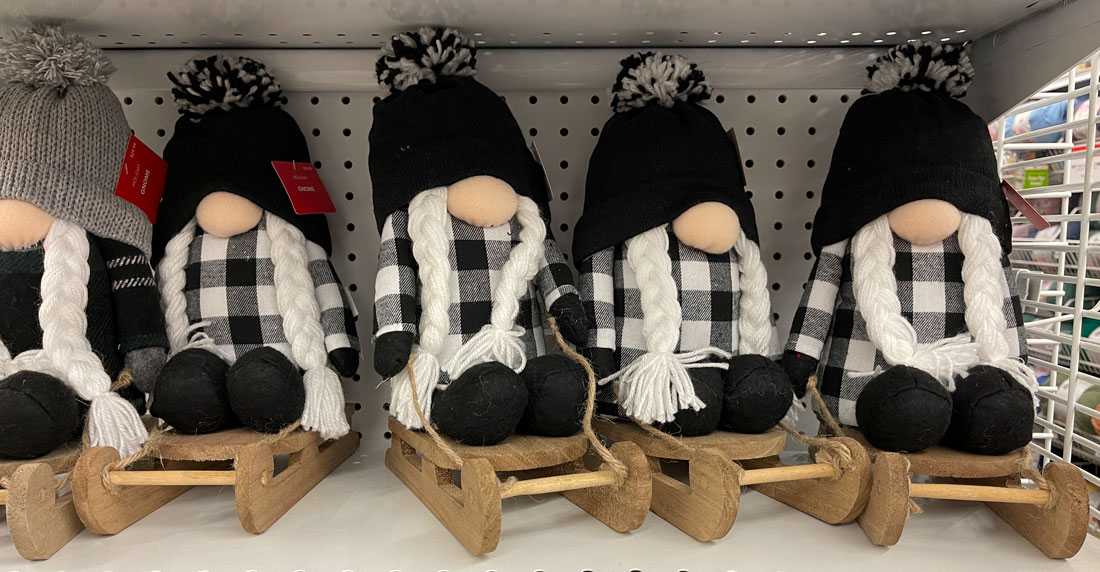
Black and white plaid is inexplicably in this Christmas season, perhaps in a warmup to next year's expected Goth trend, and these gnomes are right in style.
Among them are celebrities – Gnome Chomsky, GnomeDonald, Gnomebama, Willie Elfson Gnome, Elvis gnomes (of course!) and Signome Cowell among them. I know about some of these because I spied them in the clearance section of a gardening website.
The most devoted gnomophiles are DIYers. On a recent gnome hunt at Hobby Lobby in Spanish Fork, Utah, I asked an employee, Amy, if she had spotted any gnomes in the store and could direct us to them. Her eyes lit up.
"I want to go on this adventure," she said and off we went.
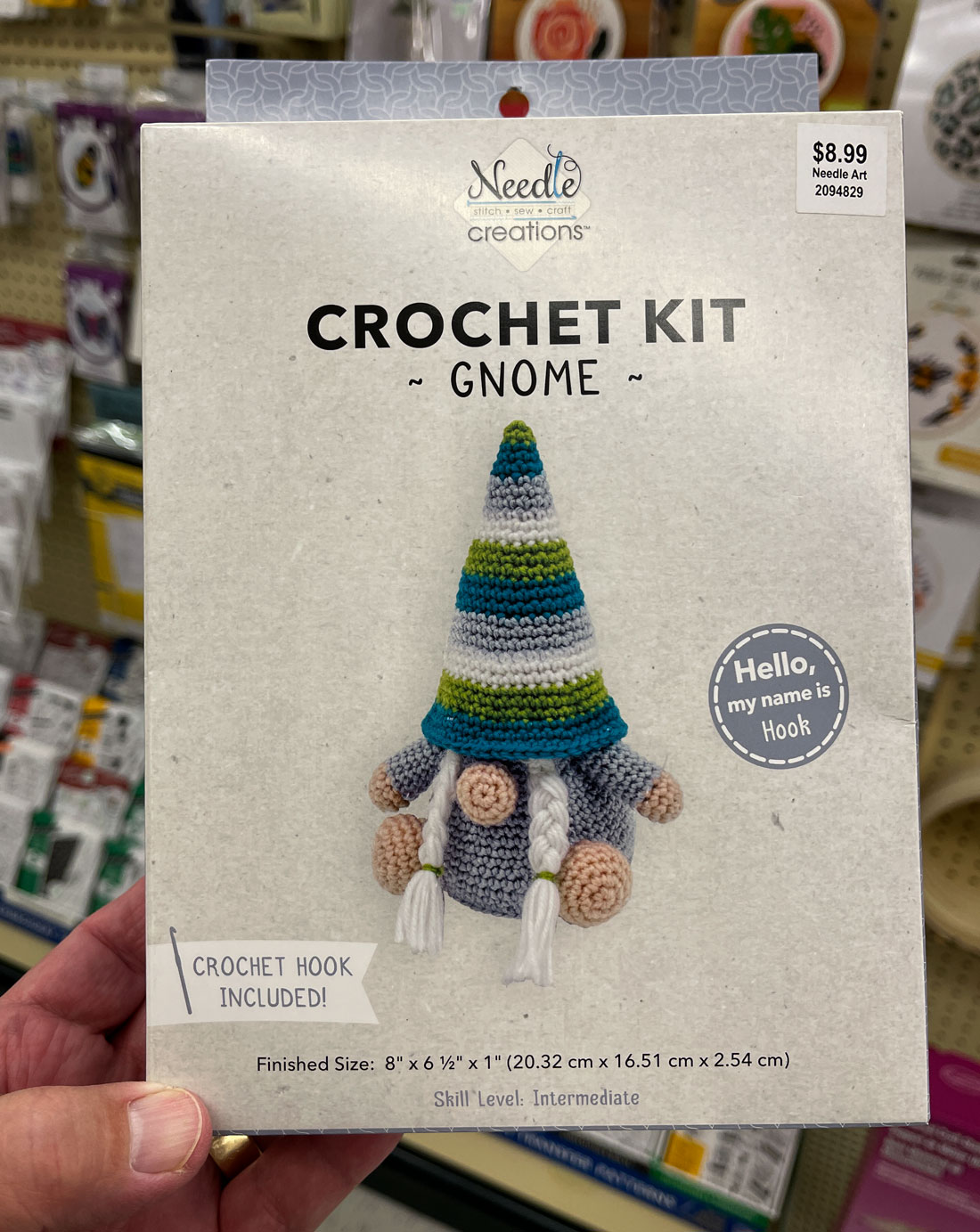

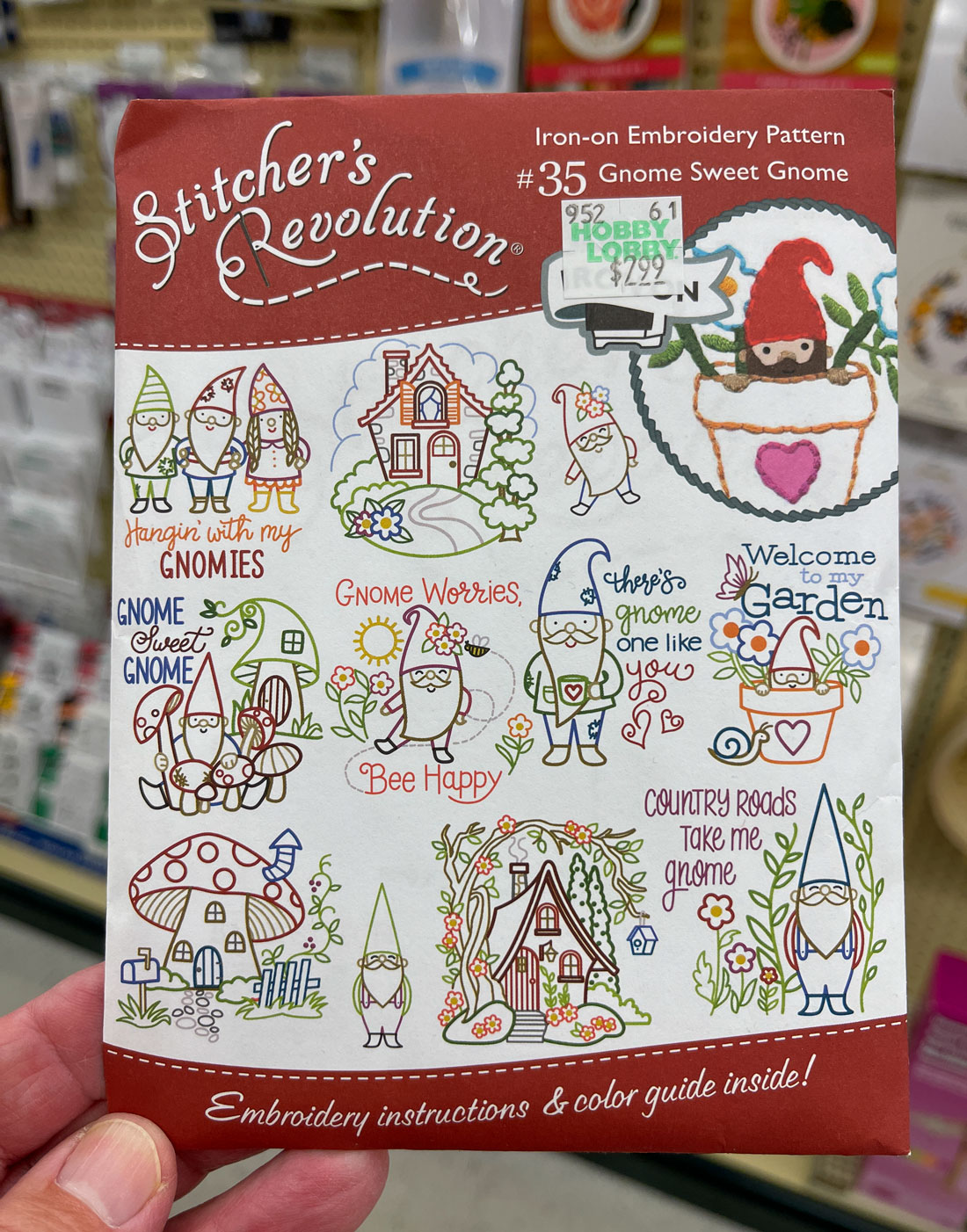
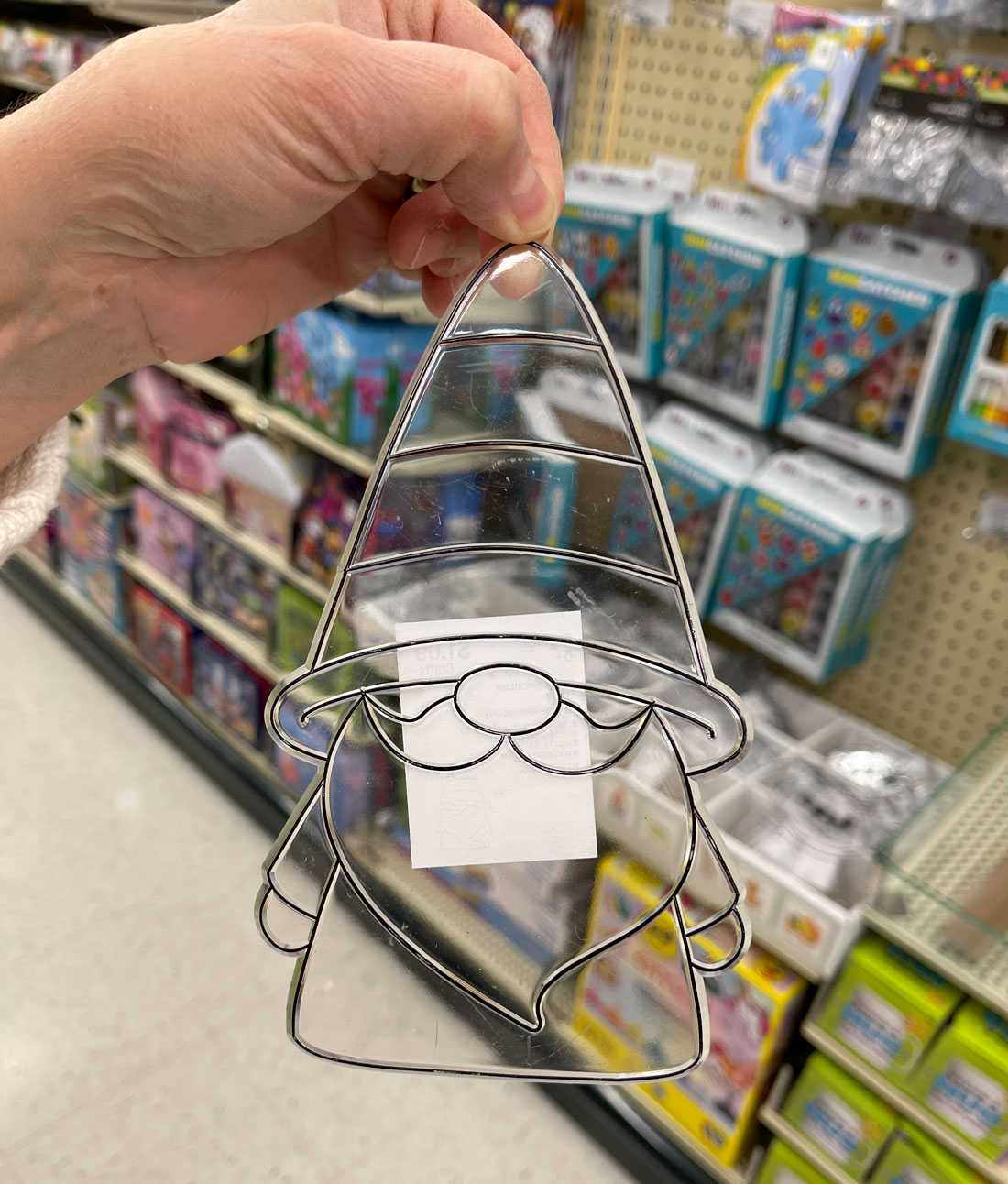
This DIY Gnome is proof that the little buggers can make themselves invisible.
Gnomes can always fall back on devoted collectors, some of whom create elaborate fairy gardens to house their gnomes. The gnome population has proliferated, no doubt due to both their longevity and DIY gnome projects. In 2008, it was estimated that there were 25 million garden gnomes in Germany alone.

A pamphlet for gnome and fairy gardens at Hobby Lobby, Spanish Fork, Utah.
Gnomes congregate at gnome-themed parks in Europe as well as gnome parades and festivals. Some are not authentic – the gnome Halloween costumes are popular.
The central problem with gnomes is that other than covering up bare spots in a lawn, they have long lacked a practical use. Software developers solved this problem by creating a popular open-source desktop environment called GNOME for Unix-like operating systems. They’ve even managed to program in the mischief of analog gnomes, as can be seen in a google search for GNOME troubleshooting. Like the statues, GNOME can freeze and crash and fail to start on cue. GNOME even deletes things. Despite these drawbacks, some developers say they still love GNOME and think it’s brilliant.
Tips for Placing Gnomes in a Garden
Put them along the front path to meet and greet your guests, close to a water fountain so they can keep cool, tuck them in among your bushes and flowers so they can pop out at visitors, place them in front or on top of gardening gaffes or in the crook of a tree branch. They enjoy being on patios and porches.
Or just pin them on your Pinterest board.
Check out these related items

Home Gnome App
The iOS app that helps you keep track of what tasks you need to do and when to do them to maintain your home well all year long.

Green Thumbometer App
The all-in-one iOS app that's a gardening calendar, gardening journal, gardening to-do list and source of gardening information.

Enough Stuff App
The Enough Stuff inventory app for iOS helps you keep track of how much you have of items so you don't buy more of them than you need.
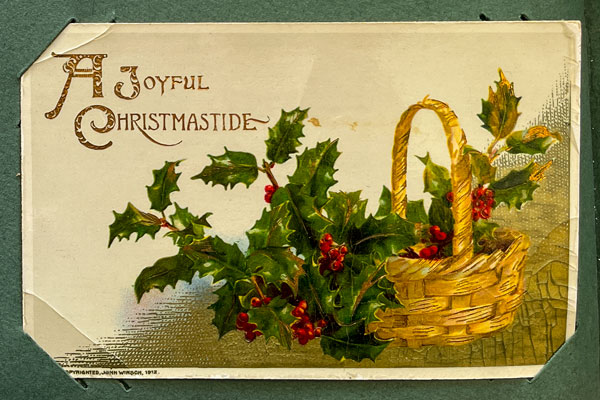
Connect With Christmas Cards
Christmas cards are having a resurgence in popularity as a safe and special way to contact loved ones.

Dolls with Souls
Japan's magnificent tradition of fine doll making is a miniature window into the nation's culture and history.

How Crafts Help Us Cope
Crafts are booming as people shelter at home during the pandemic. We explore why, as well as ways to learn a new craft without stressing out.

Enchanted Land, Part 1
A search for ancestral roots in southern France leads to a legendary land with a walled medieval town and tales of a magic sword.

Tradition in a Teapot
Unglazed clay Yixing teapots hold within them hundreds of years of tradition and craftsmanship.

Shortbread - Santa’s Favorite
Here's a Christmas secret - Santa prefers shortbread to sugar cookies. Here's a shortbread recipe to keep him happy and plump.
